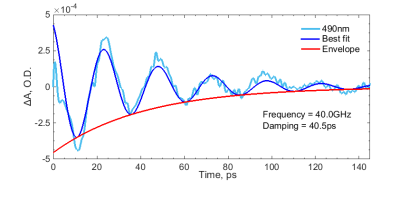Toward Artificial Photosynthesis: Understanding how porphyrin’s structure and environment influence the early electronic and nuclear dynamics.
The Sun represents an unlimited source of energy that can be harvested and ultimately converted to electricity. Solar energy is therefore the solution to not only depart from fossil fuels, but also to respond to the ever-increasing energy needs of our society. In this grand scheme, our group is interested in the fundamental understanding of light absorption and conversion by porphyrins.

In order to do so, we investigate the ultrafast behavior of a variety of natural and artificial proteins in solution (bc-cytochromes, Reaction-Centers, modified porphyrins), which entails applying microfluidics technologies to state-of-the-art pulsed laser systems. In particular, we use Ultrafast Transient Absorption and Fluorescence Up-Conversion spectroscopy.
Photocatalytic Thin Films: probing the early antibacterial properties of metallic thin films.
Have you ever wondered about self-cleaning surfaces: an object that cleanse itself just by shining light on it? Such technology already exists and the field is fast developing. In our lab we are characterising the latest metal oxides thin film to understand how these magic surfaces actually works.


By using ultrafast transient spectroscopy, we uncover the early electronic mechanisms that are at the origin of the anti-microbial properties of these new materials.
Plants under OCT surveillance: investigating plant communication and response mechanisms while under attack.
To achieve food security, we can improve the efficiency of food production while reducing the use and cost of pesticides. To tackle both challenges, efficiency and cost, we propose to select crop varieties that are more resilient against pests and diseases. However, selection and/or engineering of enhanced crop varieties, is impossible unless we have a detailed understanding of the plant’s communication and defence mechanisms, which is not yet achieved. We will address this gap of knowledge by investigating, at the cellular level, the in vivo “live” responses of plants, such as wheat, while facing a pathogen or insect attack.

In particular, we are using Optical Coherence Tomography (OCT), a non-invasive laser-based imaging technique that allows us to -see- through the leaves, to track minute morphological changes of the cell structures.
Quantum Control: shaping light to enhance chemistry.
We are now setting up a MIIPS pulse shaper and adapting it to our Helios transient absorption system. The goal is to modulate the light with which you excite your material to enhance specific electronic, nuclear and even chemical reactions!
Click here to see the equipment we are working with.
